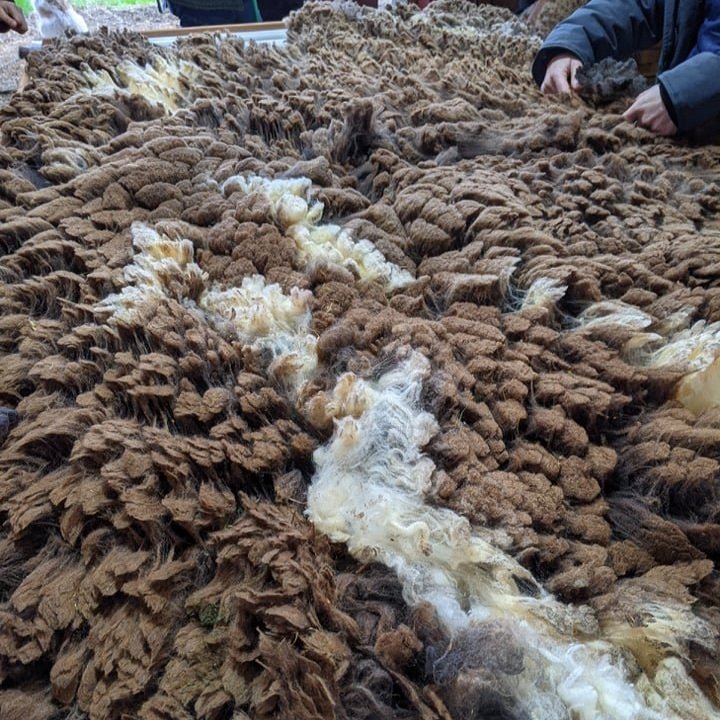It Takes a Village: Sheep Shearing at Apple Creek Merinos
Rams waiting to be sheared.
Since it happens only once a year for the whole flock, shearing is a day of gathering, participation, celebration, harvest, and shared labor. There are few things I’ve experienced that cultivate a village atmosphere the way gathering around sheep does.
In a perfect world, shearing would take place in the spring shortly before lambing season, but the reality is that not only is each flock on a different time schedule in terms of pregnancies but shearers are hard to come by. Besides experience with the shearing equipment and knowledge of the animals, the shearer also puts their own body on the line as they work through a year’s worth of wool.
Laurel’s Flock, Apple Creek Merinos
I had the great pleasure to join the shearing celebration at Apple Creek Merinos, one of the very few merino flocks in the Pacific Northwest. While many people believe that merinos do poorly in the PNW climate, Laurel took pains to find a breeder who put a lot of thought into how to give them the best chance to outlast the rain and the chill. It also helps that Laurel makes custom coats for each of her sheep, which provide a little extra warmth but primarily keep the wool beneath the coat free from moisture and hay.
Because Laurel’s sheep have their lambs between mid-December and early February, shearing happens in early December. When I asked her if the sheep get cold, she informed me that sheep skin triples in thickness in just three days! She also makes sure they have plenty of extra food and come into the barn at night.
An All-day Affair
I brought my girlfriend and my apprentice to the event, and we arrived around 10 in the morning, but shearing was already in full swing when we arrived. This was my first shearing, and there were several others present who were helping for the first time. Then, there were a few veterans, some of them with their own small flocks.
A spotted sheep sheared by Dark Side Shearing.
Counting Laurel’s parents, her friends, our small team of volunteers, and the shearers, there were about 14 of us contributing. Laurel had some donuts and snacks for helpers, and we packed a lunch because we knew we would be there a while. When the three of us took off around 4:30, there were still a few rams left to shear.
If you had told me back in college that I needed to work on a group project with 13 other people, I would have looked at you with horror and disbelief, but shearing went flawlessly. Many of us were strangers to each other, yet each of us played our role, jumped in wherever more help was needed, and collaborated beautifully. Each of us took pride in what we did, and it was certainly something to celebrate.
All Hands on Deck: Shearing Overview
Shearing happens like this (at least for a flock the size of Laurel’s, which consists of about 40 sheep): one shearer sets the pace, chooses the music, and gets to work. The shearer is one part barber and one part mixed-martial artist as they gently wrangle the sheep into safe positions for both parties (often with the sheep’s legs tucked in).
Shearing in straight, careful lines, the shearer first takes off the belly wool and then works all the way around the sheep, keeping the rest of the fleece in one piece. Because merino sheep typically have more wrinkles in their skin than other breeds, the shearer takes photos and makes notes of specific sheep so that next year, they can be even more careful around any abnormalities.
After the fleece is off the sheep, two helpers determine which part of the fleece is which and lay the whole thing on the skirting table. Then, seven of us would thoughtfully poke and prod at the fleece’s edges, pulling off any areas that are too full of hay, mats, moisture, or feces and letting them fall to the floor.
We would also assess the main section of the fleece and remove any second cuts (short pieces that result from the shearer going over the same area twice), but there were few of those (one sign of a good shearer).
Another helper then selects a sample of the fleece to send out for micron diameter testing (lower diameters mean softer fleece). Each sheep gets tested individually. While only one fiber sample is necessary for the ewes, we needed to take three from various sections of the ram fleece to ensure quality and consistency throughout (minimal change in micron diameter from section to section).
Once Laurel was satisfied with how the fleece was prepared and took a little of the fleece for herself (usually the neck fleece), we laid tissue paper across the middle of the fleece and folded it lengthwise into thirds, with another layer of tissue paper between each fold. Then, after another line of paper, we rolled the fleece from both ends and put it into a plastic bag for weighing and storage. This method reduces moisture and keeps the fleece in one piece for future buyers or shows.
While all wool is pest-resistant, mold-resistant, and even fire-resistant, merino wool is also very valuable, and anything we could do to preserve Laurel’s pristine and award-winning fleeces was worth it.
In the meantime, the shearer begins on the next sheep, and the process repeats. Helpers also sweep up and divide the wool on the floor into bags labeled for “usable skirtings” and “compost.”
Shearing Order
The shearer makes a habit of shearing the ewes and castrated males first primarily because the rams have horns, are larger, and are frequently stronger. While even some of the ewes can be feisty and difficult, the rams present a big risk to the shearer and any people standing by. By starting with the easier group of sheep, the shearer ensures that, even if the shearer get hurt later in the process, they give themselves the best chance to get the highest number of sheep sheared.
A fleece up on the skirting table.
There were only about seven rams to shear, and it was extremely important to keep them separate from the ewes during the shearing. While unexpected lambs are absolutely adorable, Laurel keeps careful track of the genes of each sheep and wants to keep them on schedule with the rest of the flock.
Next Steps for Wool after Shearing
Many of Laurel’s fleeces were reserved well in advance because, as I mentioned previously, she has an award-winning flock. As such, many of the fleeces have already made their way to their new homes, often to local handspinners interested in cleaning and processing the wool themselves.
Laurel selects some of the best fleeces to be show fleeces for awards and events in the next year, and then she sends some off to a fiber mill in Salt Lake City, Spinderellas, for processing into yarn. While we were there, Laurel also showed us a book her and her mom put together of all their natural dye experiments. I can’t wait to see what Laurel knits up next!
Laurel also let me go through all the bags of wool set aside for compost, and I filled my trunk to the brim with wool that is perfectly good even if it will take some extra processing time. Those six giant bags will probably last me all year!
Observations and Opinions
It was a long, long day, and the three of us didn’t stay the whole time, but we had seen more than enough to know that we had been part of a well-oiled machine. It was difficult to imagine how shearing would go with a larger flock—commercial flocks sometimes have thousands of sheep. The process takes several days in that case.
With a smaller flock, though, it was possible to give each animal individual care—to trim hooves, apply ointment to cuts, and redress them in their little coats after a refreshing jaunt in the pasture. This style of shearing and even the village atmosphere continues to inform my belief that small, hobby flocks make it more possible to provide individual attention to the sheep in the flock.
Compost wool in my little trunk! We’ve already begun to process it!
I am so grateful that Laurel decided to pursue the dream she had as an eight year old—to breed and raise her own flock. She gives each of them a hug every evening and maintains a full-time job besides. It’s such a pleasure to purchase wool from her knowing how much love and attention goes into the process.
Future Hopes for Sheep Breeding
My understanding of the history of sheep breeding is that most (if not all) breeds of sheep were once self-shedding thousands of years ago. For sake of ease, ranchers and shepherds bred sheep such that they did not shed and could instead be sheared when the rancher was ready. The problem with this is that it makes sheep completely dependent on human care and attention. If they were to go unsheared, they would grow wool continuously such that their hair becomes one giant mat.
While collecting wool as it is being shed would all but kill the commercial wool industry and would put even more pressure on already hard-pressed hobby farmers, it may be prudent to begin thinking about breeding strategies that make sheep more self-sufficient. In my opinion, it is an incredible act of hubris to imagine that humans will be around forever, and there’s no reason that we need to take our domesticated animals down with us.
In the meantime, we have many dedicated and caring people making the shearing process as comfortable and painless as possible.
I’ll definitely be back next year, even and especially if it happens to be on my birthday again.
In the meantime, check out my progress over at Ethical Yarn Co.!
Thanks for reading!





